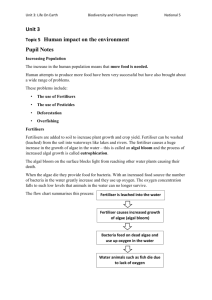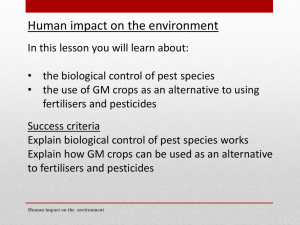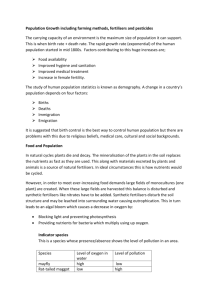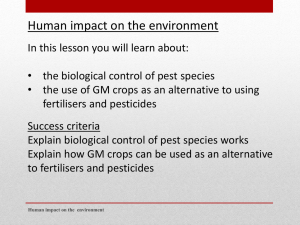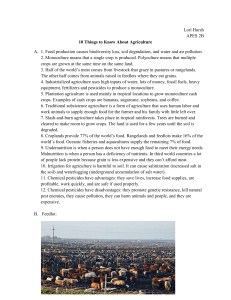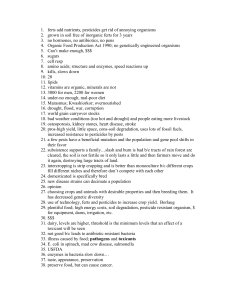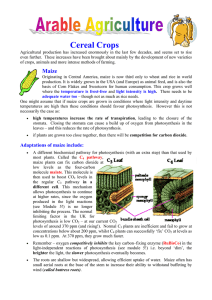SUMMARY N5 Complete life on earth Human
advertisement
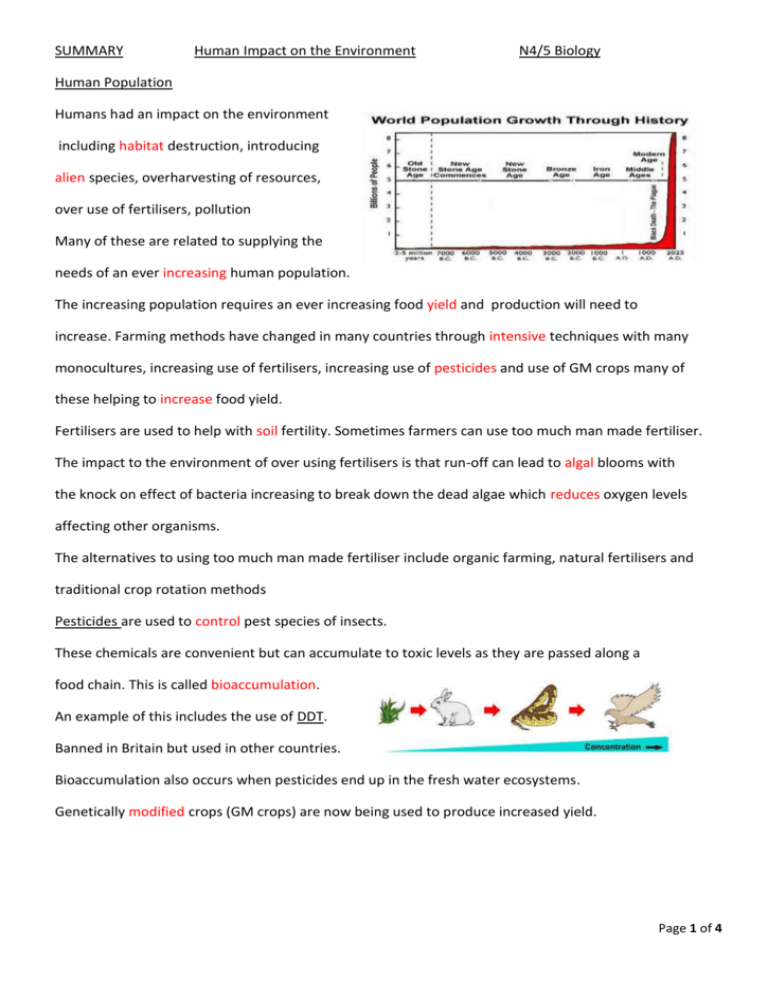
SUMMARY Human Impact on the Environment N4/5 Biology Human Population Humans had an impact on the environment including habitat destruction, introducing alien species, overharvesting of resources, over use of fertilisers, pollution Many of these are related to supplying the needs of an ever increasing human population. The increasing population requires an ever increasing food yield and production will need to increase. Farming methods have changed in many countries through intensive techniques with many monocultures, increasing use of fertilisers, increasing use of pesticides and use of GM crops many of these helping to increase food yield. Fertilisers are used to help with soil fertility. Sometimes farmers can use too much man made fertiliser. The impact to the environment of over using fertilisers is that run-off can lead to algal blooms with the knock on effect of bacteria increasing to break down the dead algae which reduces oxygen levels affecting other organisms. The alternatives to using too much man made fertiliser include organic farming, natural fertilisers and traditional crop rotation methods Pesticides are used to control pest species of insects. These chemicals are convenient but can accumulate to toxic levels as they are passed along a food chain. This is called bioaccumulation. An example of this includes the use of DDT. Banned in Britain but used in other countries. Bioaccumulation also occurs when pesticides end up in the fresh water ecosystems. Genetically modified crops (GM crops) are now being used to produce increased yield. Page 1 of 4 Monocultures This is when farmers grow large areas of the same type of crop (often year after year). This is advantageous because large machinery can be used, fertilisers and pesticides can be applied easily with machines and profit margins are maximised Disadvantages are that diseases among the crops spread easily and soil fertility can be reduced. The reintroduction of native species Another way that humans impact on the environment is the reintroduction of native species. An example of this is the European Beaver (Castor fiber) Indicator Species The impact of human activities and environmental health sometimes needs to be monitored. This could be measuring abiotic factors such as O2 levels, pollution or by sampling of organisms. One method to monitor the environment is to look at the presence or absence of Indicator species. Two examples of the use of indicator species are Lichens and freshwater invertebrates. Lichens are used as indicators of air quality particularly nitrogen dioxide (NO2) produced from vehicle emissions. Lichens are two organisms that have a symbiotic relationship. They are a fungus and an algae that grow together. The algal cells grow inside the fungal cells. Different Lichens show a range of tolerance to nitrogen gas emissions from vehicles. Usnea (nitrogen sensitive species) Fewer of this type would be found in areas of high pollution. Leafy Xanthoria (nitrogen loving species) More of this type would be found in areas of high pollution Lichens are sampled using quadrats on trees or rocks. Other factors may also influence lichens. Page 2 of 4 Freshwater invertebrates are used as indicators of water quality particularly organic pollution and oxygen levels. The presence or absence of some species will indicate the level of oxygen which is related to the level of organic material in the water. Organic material is anything that is living or was living. Organic waste like domestic or farm sewage released into freshwater will cause an increase in bacteria. These bacteria use up the oxygen in the water. The level of oxygen in the water will effect the abundance of organisms that live there. Different groups will show changes in abundance as the oxygen levels change. The organisms are sampled and their abundance counted. Sampling of freshwater invertebrates At a site with fresh water a net with a flat edge is used along the stream bed. Samples are collected by disturbing the stream bed. The collected samples are identified and counted. These species are intolerant of low oxygen levels. These species are tolerant of low oxygen levels They include mayfly, stonefly and caddisfly. They include worms, rat-tailed maggots and bloodworms. The biological control of pest species Biological control of pest species is when the pest species numbers are controlled without the use of chemicals. Instead a biological control method is used. Rabbits can become a problem for Landowners if numbers multiply too much. A solution is to introduce the virus myxomatosis which infects and kills many of the rabbits. Page 3 of 4 The biological control of plant pest species includes: • Ladybirds to kill aphids and scale insects • Caterpillar moths to kill cacti These methods are used because they avoid the use of harmful chemicals. The alternative is to use pesticides against the insects and plants. These chemicals can be harmful to non-pest species directly and in run-off into fresh water. GM crops can be used as an alternative to using fertilisers and pesticides. Drought resistance can be transferred to the GM crop which will give better growth in dry conditions Pest resistance will give enhanced yields for crops that might otherwise show a lesser yield. There are a lot of GM crops and the science is relatively new. There are differences of opinion about GM crops and there benefits. Page 4 of 4
